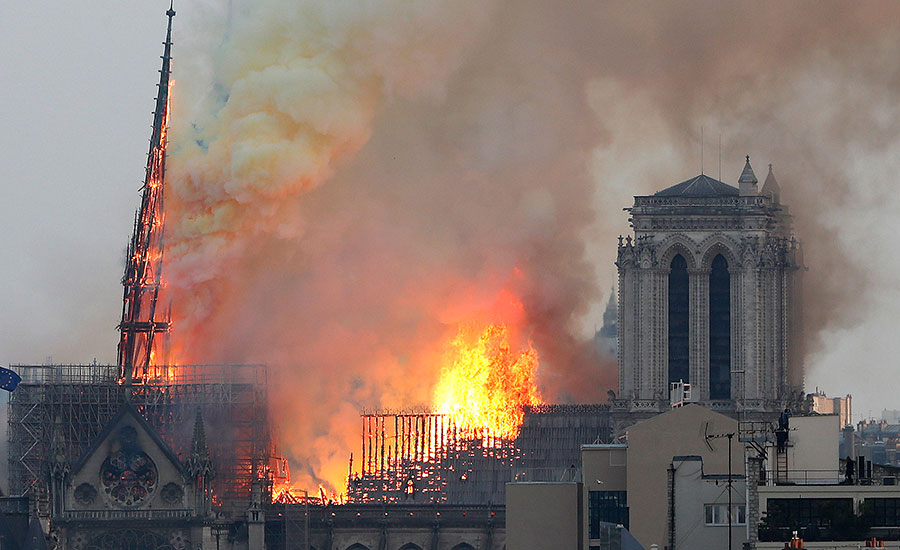Two British masonry experts familiar with centuries-old stone structures voiced concern that the catastrophic fire that collapsed the roof and spire of Notre Dame on April 15 could also have damaged stonework of the iconic Paris cathedral that may affect its stability.
The blaze that caused the damage to the 850-year-old structure also destroyed the interior wood frame. Fire crews managed to save the two bell towers and exterior stone structure.
According to media reports, firefighters officially extinguished the blaze at about 9:30 a.m Paris time (3:30 a.m EST) on April 16, with nearly 400 involved.
While authorities have not yet announced the fire's origin, French media reported that it may have been caused by construction during a $6.8-million renovation of the Notre Dame roof and spire. Initial photos and video of the fire showed smoke and then flames rising around scaffolding on the roof prior to the collapse.
However, city officials warn that it's still too early to determine an official cause.
Having witnessed the 1984 fire that gutted the UK’s medieval York Minster cathedral, the building’s master mason John David’s main concern centers on Notre Dame's ribbed stone vault.
Damaged by the fire and newly loaded with debris from the burned oak roof above, “there’s a question whether or not the remaining vault is stable,” he says, recommending a prompt survey from the nearby scaffolding.
Potential damage to the stonework also concerns Robert Duncan, a former director of David Insall Associates, which supervised repairs to the 1992 fire that partially destroyed Windsor Castle, near London.
“When limestone is subjected to very high temperatures, the molecular structure changes,” he says. Windsor’s structural investigators carried out a radar survey to spot minute limestone cracks after the fire.
Both experts advise the French authorities urgently to erect a weatherproof roof over Notre Dame, to prevent further damage.
Adds Duncan: "The first stage is to get as much information as you can [from the site] … the first 24 hours are critical."
Preservation specialist Dan Allen at CTA Architects in New York City says repair of damaged stone and mortar "will be a huge project. No one should underestimate how difficult it will be or take for granted that the masonry will be just fine after this."
The $177-million upgrade of St. Patrick's Cathedral in Manhattan completed in 2015 also included a new fire-suppression system where none had existed in the huge structure built in 1879.
Speaking at the Notre Dame site on April 15, French President Emmanuel Macron said that the French people have worked for centuries to build and make improvements to the structure and pledged that while it may take many years, "we will rebuild this cathedral. It is part of our French destiny."
Construction of the cathedral began in 1160 and was ongoing through the centuries. The destroyed 300-ft spire was made of wood and tons of lead, which could complicate recovery efforts.
Macron also committed to launching a "national subscription" on Tuesday, which would also be open to worldwide pledges of support.
The Notre Dame fire seriously injured one firefighter, according to local reports. No deaths or other injuries have been reported. Police evacuated nearby apartment buildings and other structures on the island in the River Seine where the church is located.
During the blaze, the fire brigade, police and municipal agents created a "formidable human chain" to save priceless relics and works of art, said Paris Mayor Anne Hidalgo on Twitter. "The Crown of Thorns, the Tunic of Saint Louis and several other major works are now in a safe place," she added.
Additional reporting by Caitlin Russell







